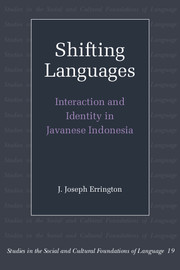Book contents
- Frontmatter
- Contents
- List of figures, maps, and tables
- Acknowledgements
- Preface: suggestions for use
- Note on orthography and transcription
- Map 1 The Indonesian archipelago
- Map 2 Eastern Central Java
- 1 Introduction
- 2 A city, two hamlets, and the state
- 3 Speech styles, hierarchy, and community
- 4 National development, national language
- 5 Public language and authority
- 6 Interactional and referential identities
- 7 Language contact and language salad
- 8 Speech modeling
- 9 Shifting styles and modeling thought
- 10 Javanese–Indonesian code switching
- 11 Shifting perspectives
- Notes
- Works cited
- Index of javanese and indonesian words
- General index
- Titles in the series
9 - Shifting styles and modeling thought
Published online by Cambridge University Press: 01 June 2011
- Frontmatter
- Contents
- List of figures, maps, and tables
- Acknowledgements
- Preface: suggestions for use
- Note on orthography and transcription
- Map 1 The Indonesian archipelago
- Map 2 Eastern Central Java
- 1 Introduction
- 2 A city, two hamlets, and the state
- 3 Speech styles, hierarchy, and community
- 4 National development, national language
- 5 Public language and authority
- 6 Interactional and referential identities
- 7 Language contact and language salad
- 8 Speech modeling
- 9 Shifting styles and modeling thought
- 10 Javanese–Indonesian code switching
- 11 Shifting perspectives
- Notes
- Works cited
- Index of javanese and indonesian words
- General index
- Titles in the series
Summary
In chapter 3, ngoko and básá were sketched first as a “basic” and a stylistically “augmentary” way of speaking, and then as aesthetically unequal social competences, unevenly distributed across lines of territorial hierarchy. Both sorts of difference, structural and social, make it easy to think of “switching between these [sub]codes in Javanese” as “tantamount to code switching between different languages” (Romaine 1995:321). Under a comparative profile, then, multistylistic Javanese usage can be treated as a special subcase of bilingual usage, and therefore like that involving Javanese and Indonesian which I sketch in the next chapter.
But ngoko and básá are also integrally related through their groundings in interactional self/other relations between native speakers of a single language. So multistylistic usage needs to be considered first with an eye to the kinds of dynamic participant roles sketched in chapter 8. I sketch style shifting here, then, relative to básá's pragmatic markedness, over and against ngoko, for a “thou-orientation.” This keys to what I called in chapter 3 the generic appellative function of básá (recalling Buéhler's terminology), making its use presupposing of a stance to a copresent addressee which is not necessarily presupposed by use of ngoko.
- Type
- Chapter
- Information
- Shifting Languages , pp. 139 - 154Publisher: Cambridge University PressPrint publication year: 1998

